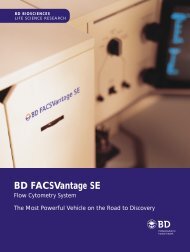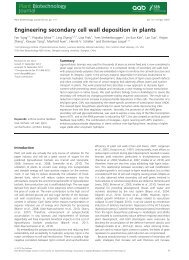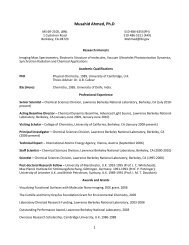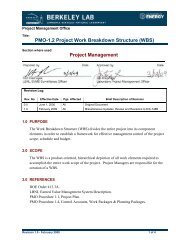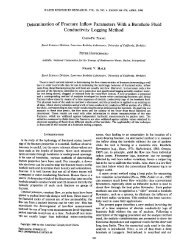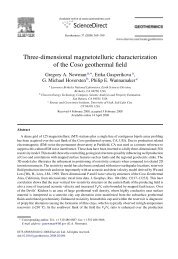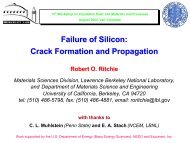Production of the antimalarial drug precursor artemisinic acid
Production of the antimalarial drug precursor artemisinic acid
Production of the antimalarial drug precursor artemisinic acid
You also want an ePaper? Increase the reach of your titles
YUMPU automatically turns print PDFs into web optimized ePapers that Google loves.
LETTERS<br />
<strong>Production</strong> <strong>of</strong> <strong>the</strong> <strong>antimalarial</strong> <strong>drug</strong> <strong>precursor</strong><br />
<strong>artemisinic</strong> <strong>acid</strong> in engineered yeast<br />
Dae-Kyun Ro 1 *, Eric M. Paradise 2 *, Mario Ouellet 1 , Karl J. Fisher 6 , Karyn L. Newman 1 , John M. Ndungu 3 ,<br />
Kimberly A. Ho 1 , Rachel A. Eachus 1 , Timothy S. Ham 4 , James Kirby 2 , Michelle C. Y. Chang 1 , Sydnor T. Wi<strong>the</strong>rs 2 ,<br />
Yoichiro Shiba 2 , Richmond Sarpong 3 & Jay D. Keasling 1,2,4,5<br />
Malaria is a global health problem that threatens 300–500 million<br />
people and kills more than one million people annually 1 . Disease<br />
control is hampered by <strong>the</strong> occurrence <strong>of</strong> multi-<strong>drug</strong>-resistant<br />
strains <strong>of</strong> <strong>the</strong> malaria parasite Plasmodium falciparum 2,3 . Syn<strong>the</strong>tic<br />
<strong>antimalarial</strong> <strong>drug</strong>s and malarial vaccines are currently being<br />
developed, but <strong>the</strong>ir efficacy against malaria awaits rigorous clinical<br />
testing 4,5 . Artemisinin, a sesquiterpene lactone endoperoxide<br />
extracted from Artemisia annua L (family Asteraceae; commonly<br />
known as sweet wormwood), is highly effective against multi<strong>drug</strong>-resistant<br />
Plasmodium spp., but is in short supply and<br />
unaffordable to most malaria sufferers 6 . Although total syn<strong>the</strong>sis<br />
<strong>of</strong> artemisinin is difficult and costly 7 , <strong>the</strong> semi-syn<strong>the</strong>sis <strong>of</strong><br />
artemisinin or any derivative from microbially sourced <strong>artemisinic</strong><br />
<strong>acid</strong>, its immediate <strong>precursor</strong>, could be a cost-effective,<br />
environmentally friendly, high-quality and reliable source <strong>of</strong><br />
artemisinin 8,9 . Here we report <strong>the</strong> engineering <strong>of</strong> Saccharomyces<br />
cerevisiae to produce high titres (up to 100 mg l 21 ) <strong>of</strong> <strong>artemisinic</strong><br />
<strong>acid</strong> using an engineered mevalonate pathway, amorphadiene<br />
synthase, and a novel cytochrome P450 monooxygenase<br />
(CYP71AV1) from A. annua that performs a three-step oxidation<br />
<strong>of</strong> amorpha-4,11-diene to <strong>artemisinic</strong> <strong>acid</strong>. The syn<strong>the</strong>sized <strong>artemisinic</strong><br />
<strong>acid</strong> is transported out and retained on <strong>the</strong> outside <strong>of</strong> <strong>the</strong><br />
engineered yeast, meaning that a simple and inexpensive purification<br />
process can be used to obtain <strong>the</strong> desired product. Although<br />
<strong>the</strong> engineered yeast is already capable <strong>of</strong> producing <strong>artemisinic</strong><br />
<strong>acid</strong> at a significantly higher specific productivity than A. annua,<br />
yield optimization and industrial scale-up will be required to raise<br />
<strong>artemisinic</strong> <strong>acid</strong> production to a level high enough to reduce<br />
artemisinin combination <strong>the</strong>rapies to significantly below <strong>the</strong>ir<br />
current prices.<br />
We engineered <strong>artemisinic</strong>-<strong>acid</strong>-producing yeast in three steps, by<br />
(1) engineering <strong>the</strong> farnesyl pyrophosphate (FPP) biosyn<strong>the</strong>tic pathway<br />
to increase FPP production and decrease its use for sterols, (2)<br />
introducing <strong>the</strong> amorphadiene synthase gene (ADS) fromA. annua<br />
into <strong>the</strong> high FPP producer to convert FPP to amorphadiene, and (3)<br />
cloning a novel cytochrome P450 that performs a three-step oxidation<br />
<strong>of</strong> amorphadiene to <strong>artemisinic</strong> <strong>acid</strong> from A. annua and expressing it<br />
in <strong>the</strong> amorphadiene producer (Fig. 1). The first committed reaction<br />
in artemisinin biosyn<strong>the</strong>sis is catalysed by ADS 10 , which has been<br />
characterized and used for de novo production <strong>of</strong> amorphadiene in<br />
Escherichia coli 11 . To test for improvements in FPP production, we<br />
expressed ADS under <strong>the</strong> control <strong>of</strong> <strong>the</strong> GAL1 promoter on <strong>the</strong><br />
pRS425 plasmid (see Supplementary Information for details). Yeast<br />
engineered with ADS alone produced a low quantity <strong>of</strong> amorphadiene<br />
(Fig. 2, strain EPY201, 4.4 mg l 21 amorphadiene).<br />
To increase FPP production in S. cerevisiae, <strong>the</strong> expression <strong>of</strong><br />
several genes responsible for FPP syn<strong>the</strong>sis was upregulated, and one<br />
gene responsible for FPP conversion to sterols was downregulated.<br />
All <strong>of</strong> <strong>the</strong>se modifications to <strong>the</strong> host strain were made by chromosomal<br />
integration to ensure <strong>the</strong> genetic stability <strong>of</strong> <strong>the</strong> host strain.<br />
Overexpression <strong>of</strong> a truncated, soluble form <strong>of</strong> 3-hydroxy-3-methylglutaryl-coenzyme<br />
A reductase (tHMGR) 12 improved amorphadiene<br />
production approximately fivefold (Fig. 2, strain EYP208). Downregulation<br />
<strong>of</strong> ERG9, which encodes squalene synthase (<strong>the</strong> first step<br />
after FPP in <strong>the</strong> sterol biosyn<strong>the</strong>tic pathway), using a methioninerepressible<br />
promoter (PMET3) 13 increased amorphadiene production<br />
an additional tw<strong>of</strong>old (Fig. 2, strain EPY225). Although upc2-1, a<br />
semi-dominant mutant allele that enhances <strong>the</strong> activity <strong>of</strong> UPC2<br />
(a global transcription factor regulating <strong>the</strong> biosyn<strong>the</strong>sis <strong>of</strong> sterols in<br />
S. cerevisiae) 14 , had only a modest effect on amorphadiene production<br />
when overexpressed in <strong>the</strong> EPY208 background (Fig. 2,<br />
strain EPY210), <strong>the</strong> combination <strong>of</strong> downregulating ERG9 and<br />
overexpressing upc2-1 increased amorphadiene production to<br />
105 mg l 21 (Fig. 2, strain EPY213). Integration <strong>of</strong> an additional<br />
copy <strong>of</strong> tHMGR into <strong>the</strong> chromosome fur<strong>the</strong>r increased amorphadiene<br />
production by 50% to 149 mg l 21 (Fig. 2, strain EPY219).<br />
Although overexpression <strong>of</strong> <strong>the</strong> gene encoding FPP synthase<br />
(ERG20) had little effect on total amorphadiene production (Fig. 2,<br />
strain EPY224), <strong>the</strong> specific production increased by about 10%<br />
owing to a decrease in cell density. Combining all <strong>of</strong> <strong>the</strong>se modifications<br />
resulted in a strain (EPY224) able to produce 153 mg l 21<br />
amorphadiene, a sesquiterpene production level nearly 500-fold<br />
higher than previously reported 15 .<br />
To create a strain that produced <strong>artemisinic</strong> <strong>acid</strong> from amorphadiene,<br />
we isolated genes encoding enzymes responsible for oxidizing<br />
amorphadiene to <strong>artemisinic</strong> <strong>acid</strong> in A. annua. Artemisinin is a<br />
sesquiterpene lactone derivative, which is <strong>the</strong> most widespread and<br />
characteristic class <strong>of</strong> secondary metabolites found in Asteraceae<br />
(also known as Compositae) 16 . We hypo<strong>the</strong>sized that plants belonging<br />
to <strong>the</strong> Asteraceae family would share common ancestor enzymes for<br />
<strong>the</strong> early steps in <strong>the</strong> biosyn<strong>the</strong>sis <strong>of</strong> sesquiterpene lactones, and<br />
<strong>the</strong>refore undertook a comparative genomic analysis <strong>of</strong> plants in <strong>the</strong><br />
Asteraceae family. Previous cell-free assays have indicated that a<br />
cytochrome P450 monooxygenase (P450) catalyses <strong>the</strong> first regiospecific<br />
hydroxylation <strong>of</strong> amorphadiene (Fig. 1) in A. annua 17 . We thus<br />
retrieved P450-expressed-sequence tags (ESTs) from <strong>the</strong> Asteraceae<br />
EST-database generated from two Asteraceae crops, sunflower and<br />
lettuce (http://www.cgpdb.ucdavis.edu). Use <strong>of</strong> degenerate primers<br />
highly specific to <strong>the</strong> Asteraceae CYP71 and CYP82 subfamilies (<strong>the</strong><br />
most abundant P450 subfamilies in Asteraceae) enabled <strong>the</strong> isolation<br />
1 California Institute <strong>of</strong> Quantitative Biomedical Research, 2 Department <strong>of</strong> Chemical Engineering, 3 Department <strong>of</strong> Chemistry, 4 Department <strong>of</strong> Bioengineering, and 5 Berkeley Center<br />
for Syn<strong>the</strong>tic Biology, Lawrence Berkeley National Laboratory, University <strong>of</strong> California, Berkeley, California 94720, USA. 6 Amyris Biotechnologies Inc., Emeryville, California<br />
94608, USA.<br />
*These authors contributed equally to this work.<br />
940<br />
© 2006 Nature Publishing Group<br />
Vol 440|13 April 2006|doi:10.1038/nature04640
NATURE|Vol 440|13 April 2006 LETTERS<br />
<strong>of</strong> several unique P450 fragments from an A. annua trichome-enriched<br />
complementary DNA pool. Using BLAST 18 analyses <strong>of</strong> <strong>the</strong>se P450 gene<br />
fragments against sunflower and lettuce ESTs, we identified a single A.<br />
annua P450 gene fragment that had surprisingly high sequence<br />
identity (85–88% at <strong>the</strong> amino-<strong>acid</strong> level) to ESTs <strong>of</strong> unknown<br />
function from both sunflower and lettuce. Sequence identity <strong>of</strong> this<br />
A. annua P450 fragment to o<strong>the</strong>r P450 fragments outside <strong>the</strong> Asteraceae<br />
family was much lower (,50% at <strong>the</strong> amino-<strong>acid</strong> level),<br />
indicating that this P450 is highly conserved in three distantly related<br />
genera in <strong>the</strong> Asteraceae family, but not in plants outside <strong>the</strong><br />
Asteraceae family. This P450 gene was <strong>the</strong>refore a good candidate<br />
for a conserved Asteraceae sesquiterpene lactone biosyn<strong>the</strong>tic enzyme.<br />
The corresponding full-length P450 cDNA (CYP71AV1), encoding<br />
an open reading frame <strong>of</strong> 495 amino <strong>acid</strong>s, was recovered from<br />
A. annua. Phylogenetic analysis showed that CYP71AV1 shares a<br />
close lineage with o<strong>the</strong>r P450s that catalyse <strong>the</strong> hydroxylation <strong>of</strong><br />
Figure 1 | Schematic representation <strong>of</strong> <strong>the</strong> engineered <strong>artemisinic</strong> <strong>acid</strong><br />
biosyn<strong>the</strong>tic pathway in S. cerevisiae strain EPY224 expressing CYP71AV1<br />
and CPR. Genes from <strong>the</strong> mevalonate pathway in S. cerevisiae that are<br />
directly upregulated are shown in blue; those that are indirectly upregulated<br />
by upc2-1 expression are in purple; and <strong>the</strong> red line denotes repression <strong>of</strong><br />
ERG9 in strain EPY224. The pathway intermediates IPP, DMAPP and GPP<br />
are defined as isopentenyl pyrophosphate, dimethyl allyl pyrophosphate and<br />
geranyl pyrophosphate, respectively. Green arrows indicate <strong>the</strong> biochemical<br />
pathway leading from farnesyl pyrophosphate (FPP) to <strong>artemisinic</strong> <strong>acid</strong>,<br />
which was introduced into S. cerevisiae from A. annua. The three oxidation<br />
steps converting amorphadiene to <strong>artemisinic</strong> <strong>acid</strong> by CYP71AV1 and CPR<br />
are shown.<br />
© 2006 Nature Publishing Group<br />
monoterpenoids (CYP71D13/18; ref. 19), sesquiterpenoids<br />
(CYP71D20; ref. 20) or diterpenoids (CYP71D16; ref. 21), fur<strong>the</strong>r<br />
suggesting <strong>the</strong> potential involvement <strong>of</strong> this P450 in terpenoid<br />
metabolism (Supplementary Information). For functional, heterologous<br />
expression <strong>of</strong> CYP71AV1, its native redox partner, NADPH:<br />
cytochrome P450 oxidoreductase (CPR), was also isolated from<br />
A. annua, and its biochemical function was confirmed in vitro.<br />
(Michaelis–Menten constants (K m) for cytochrome c and NADPH<br />
were determined to be 4.3 ^ 0.7 mM and 23.0 ^ 4.4 mM (mean ^<br />
s.d., n ¼ 3), respectively.)<br />
Using A. annua CPR as a redox partner for CYP71AV1, we <strong>the</strong>n<br />
investigated whe<strong>the</strong>r CYP71AV1 could catalyse <strong>the</strong> conversion <strong>of</strong><br />
amorphadiene to more oxygenated products in vivo. The transgenic<br />
yeast strain EPY224 was transformed with a vector harbouring CPR<br />
and CYP71AV1 under <strong>the</strong> control <strong>of</strong> galactose-inducible promoters.<br />
After galactose induction, <strong>the</strong> e<strong>the</strong>r-extractable fraction <strong>of</strong> <strong>the</strong> yeast<br />
culture medium and cell pellet were analysed by gas chromatography<br />
mass spectrometry (GC–MS). A single chromatographic peak<br />
unique to EPY224 co-expressing CYP71AV1 and CPR was detected<br />
in both <strong>the</strong> yeast culture medium and cell pellet, but was not present<br />
in control yeast (EPY224 expressing CPR only). However, more than<br />
95% <strong>of</strong> this novel compound was associated with <strong>the</strong> cell pellet. In<br />
GC–MS analysis, <strong>the</strong> electron-impact mass spectrum and retention<br />
time <strong>of</strong> this compound were identical to those <strong>of</strong> <strong>artemisinic</strong><br />
<strong>acid</strong> isolated from A. annua (Fig. 3). In a shake-flask culture,<br />
32 ^ 13 mg l 21 (mean ^ s.d., n ¼ 7) <strong>artemisinic</strong> <strong>acid</strong> was produced<br />
from EPY224 expressing CYP71AV1 and CPR. Notably, <strong>the</strong> pathway<br />
intermediates, <strong>artemisinic</strong> alcohol and <strong>artemisinic</strong> aldehyde, were<br />
present at negligible levels in <strong>the</strong> culture medium and cell pellets <strong>of</strong><br />
EPY224 engineered with CYP71AV1 and CPR. (Artemisinic alcohol<br />
was present at less than 5% <strong>of</strong> <strong>the</strong> <strong>artemisinic</strong> <strong>acid</strong> in <strong>the</strong> cell pellet,<br />
and no <strong>artemisinic</strong> aldehyde was detected.)<br />
Almost all (.96%) <strong>of</strong> <strong>the</strong> syn<strong>the</strong>sized <strong>artemisinic</strong> <strong>acid</strong> was<br />
removed from <strong>the</strong> cell pellet by washing with alkaline buffer (pH 9<br />
Tris-HCl buffer supplemented with 1.2 M sorbitol), with less than<br />
2% remaining in <strong>the</strong> washed cell pellet or culture medium. Thus, it<br />
seems that <strong>artemisinic</strong> <strong>acid</strong> is efficiently transported out <strong>of</strong> yeast cells<br />
but remains bound to <strong>the</strong> cell surface when it is protonated under<br />
<strong>acid</strong>ic culture conditions. We used this feature to develop a one-step<br />
purification method: a single silica gel column chromatographic<br />
separation <strong>of</strong> e<strong>the</strong>r-extracted <strong>artemisinic</strong> <strong>acid</strong> from <strong>the</strong> wash buffer<br />
routinely yielded .95% pure <strong>artemisinic</strong> <strong>acid</strong>. In a one-litre aerated<br />
bioreactor, 115 mg <strong>of</strong> <strong>artemisinic</strong> <strong>acid</strong> was produced, <strong>of</strong> which 76 mg<br />
was purified using this method. The 1 Hand 13 C nuclear magnetic<br />
resonance spectra <strong>of</strong> this yeast-derived <strong>artemisinic</strong> <strong>acid</strong> were identical<br />
to those <strong>of</strong> <strong>artemisinic</strong> <strong>acid</strong> isolated from <strong>the</strong> leaves <strong>of</strong> A. annua, and<br />
are consistent with previously reported values 22,23 . We can <strong>the</strong>refore<br />
confirm that structurally au<strong>the</strong>ntic <strong>artemisinic</strong> <strong>acid</strong> is syn<strong>the</strong>sized by<br />
Figure 2 | <strong>Production</strong> <strong>of</strong> amorphadiene by S. cerevisiae strains. The various<br />
S. cerevisiae strains are described in <strong>the</strong> text. Cultures were sampled after<br />
144 h <strong>of</strong> growth, and amorphadiene levels were quantified. Data, shown as<br />
total production, are mean ^ s.d. (n ¼ 3).<br />
941
LETTERS NATURE|Vol 440|13 April 2006<br />
transgenic yeast de novo. The transgenic yeast produced <strong>artemisinic</strong><br />
<strong>acid</strong> at a biomass fraction comparable to that produced by A. annua<br />
(4.5% dry weight in yeast compared to 1.9% <strong>artemisinic</strong> <strong>acid</strong> and<br />
0.16% artemisinin in A. annua) but over a much shorter time (4–5<br />
days for yeast versus several months for A. annua). As such, <strong>the</strong><br />
specific productivity <strong>of</strong> <strong>the</strong> engineered yeast strain is nearly two<br />
orders <strong>of</strong> magnitude greater than A. annua.<br />
Three-step oxidations by P450 enzymes have been previously<br />
reported in plant hormone gibberellin biosyn<strong>the</strong>tic pathways 24,25 .<br />
We conducted in vitro enzyme assays to identify whe<strong>the</strong>r CYP71AV1<br />
catalyses all three oxidation reactions from amorphadiene to <strong>artemisinic</strong><br />
<strong>acid</strong>. Microsomes were isolated from S. cerevisiae strain<br />
YPH499 expressing ei<strong>the</strong>r CPR alone or CPR and CYP71AV1, and<br />
incubated with pathway intermediates (amorphadiene, <strong>artemisinic</strong><br />
alcohol or <strong>artemisinic</strong> aldehyde) (Fig. 4). Microsomes from <strong>the</strong> CPR<br />
control did not catalyse <strong>the</strong> conversion <strong>of</strong> any pathway intermediate<br />
to more oxidized products, whereas efficient conversion <strong>of</strong> amorphadiene,<br />
<strong>artemisinic</strong> alcohol and <strong>artemisinic</strong> aldehyde to <strong>the</strong> final<br />
product <strong>artemisinic</strong> <strong>acid</strong> was detected in microsomes containing<br />
Figure 3 | GC–MS analysis <strong>of</strong> <strong>artemisinic</strong> <strong>acid</strong> produced from A. annua and<br />
transgenic yeast. a, Cell pellets from S. cerevisiae strain EPY224 expressing<br />
CPR or CPR and CYP71AV1 were washed using an alkaline buffer followed<br />
by <strong>acid</strong>ification and e<strong>the</strong>r extraction. Artemisinic <strong>acid</strong> was extracted from<br />
A. annua leaves using hexane. Methyl esters <strong>of</strong> both samples were prepared<br />
with trimethylsilyl-diazomethane before GC–MS analysis. The internal<br />
standard (IS) is <strong>the</strong> methyl ester <strong>of</strong> 4-octylbenzoic <strong>acid</strong>. b, c, Mass spectra<br />
and retention times <strong>of</strong> <strong>artemisinic</strong> <strong>acid</strong> from yeast (b) and A. annua (c).<br />
RT, retention time (in min).<br />
942<br />
CYP71AV1 and CPR. These in vitro assays demonstrate unambiguously<br />
that recombinant CYP71AV1 is able to catalyse three oxidation<br />
reactions at <strong>the</strong> C12 position <strong>of</strong> amorphadiene. Previous in vitro<br />
enzyme assays using A. annua protein extract have suggested that<br />
soluble alcohol and aldehyde dehydrogenases and a C11,13 doublebond<br />
reductase (which acts on <strong>the</strong> aldehyde) are involved in<br />
artemisinin biosyn<strong>the</strong>sis 17 . Although we cannot exclude a catalytic<br />
role for additional alcohol and aldehyde dehydrogenases in artemisinin<br />
syn<strong>the</strong>sis in A. annua, <strong>the</strong> efficient in vivo conversion <strong>of</strong><br />
amorpha-4,11-diene to <strong>artemisinic</strong> <strong>acid</strong> by recombinant<br />
CYP71AV1 indicates that <strong>the</strong> membrane-bound, multifunctional<br />
CYP71AV1 is a key contributor to artemisinin biosyn<strong>the</strong>sis.<br />
In summary, we have created a strain <strong>of</strong> S. cerevisiae capable <strong>of</strong><br />
producing high levels <strong>of</strong> <strong>artemisinic</strong> <strong>acid</strong> by engineering <strong>the</strong> FPP<br />
biosyn<strong>the</strong>tic pathway to increase FPP production and by expressing<br />
amorphadiene synthase, a novel cytochrome P450 and its redox<br />
partner from A. annua. Given <strong>the</strong> existence <strong>of</strong> known, relatively highyielding<br />
chemistry for <strong>the</strong> conversion <strong>of</strong> <strong>artemisinic</strong> <strong>acid</strong> to artemisinin<br />
or any o<strong>the</strong>r derivative that might be desired 8,9 , microbially<br />
produced <strong>artemisinic</strong> <strong>acid</strong> is a viable source <strong>of</strong> this potent family <strong>of</strong><br />
<strong>antimalarial</strong> <strong>drug</strong>s. Upon optimization <strong>of</strong> product titres, a conservative<br />
analysis suggests that artemisinin combination <strong>the</strong>rapies could<br />
be <strong>of</strong>fered significantly below <strong>the</strong>ir current prices (see Supplementary<br />
Information). In addition to cost savings, this bioprocess should not<br />
be subject to factors like wea<strong>the</strong>r or political climates that may affect<br />
plant cultivation. Fur<strong>the</strong>rmore, <strong>artemisinic</strong> <strong>acid</strong> from a microbial<br />
source can be extracted using an environmentally friendly process<br />
without worrying about contamination by o<strong>the</strong>r terpenes that are<br />
produced by plants, <strong>the</strong>reby increasing <strong>the</strong> ease with which it can be<br />
produced while reducing purification costs.<br />
Figure 4 | In vitro enzyme assays for CYP71AV1 activities. Microsomes<br />
were isolated from S. cerevisiae strain YPH499 expressing CPR (control) or<br />
CPR and CYP71AV1 (CYP71AV1). a–c, For each enzyme assay, 10 mM<br />
amorphadiene (a), 25 mM <strong>artemisinic</strong> alcohol (b) or25mM <strong>artemisinic</strong><br />
aldehyde (c) was used. Chromatographic peaks for <strong>the</strong> substrates used are<br />
indicated with asterisks. E<strong>the</strong>r-extractable fractions were derivatized and<br />
analysed by GC–MS in selective ion mode (m/z: 121, 189, 204, 218, 220 and<br />
248). Enzymatic products are as indicated: 1, <strong>artemisinic</strong> alcohol (retention<br />
time 13.20 min); 2, <strong>artemisinic</strong> aldehyde (retention time 11.79 min);<br />
3, <strong>artemisinic</strong> <strong>acid</strong> (retention time 13.58 min, detected as methyl ester).<br />
© 2006 Nature Publishing Group
NATURE|Vol 440|13 April 2006 LETTERS<br />
METHODS<br />
Detailed descriptions <strong>of</strong> <strong>the</strong> methods used in <strong>the</strong> generation and characterization<br />
<strong>of</strong> S. cerevisiae EPY strains, <strong>the</strong> cloning <strong>of</strong> CYP71AV1 and CPR, and <strong>the</strong> semisyn<strong>the</strong>sis<br />
<strong>of</strong> <strong>artemisinic</strong> alcohol and <strong>artemisinic</strong> aldehyde are provided in<br />
Supplementary Information.<br />
Chemicals and plant material. Au<strong>the</strong>ntic <strong>artemisinic</strong> <strong>acid</strong> was purchased from<br />
Apin Chemicals or extracted from A. annua leaves with hexane, as described in<br />
Supplementary Information. A. annua plants were started from seeds (Sandeman<br />
Seeds) and grown in a greenhouse at <strong>the</strong> University <strong>of</strong> California, Berkeley.<br />
GC–MS analysis <strong>of</strong> amorphadiene. Amorphadiene production by <strong>the</strong> various<br />
strains was measured by GC–MS using a dodecane layer to trap volatile<br />
amorphadiene (see Supplementary Information for details). Amorphadiene<br />
(90% pure) was prepared by fermentation using an E. coli strain 11 , and was used<br />
to construct a standard curve to determine amorphadiene production levels.<br />
In vivo production, purification and chemical analysis <strong>of</strong> <strong>artemisinic</strong> <strong>acid</strong>.<br />
Pre-cultured EPY224 strains transformed with pESCURA::CPR or pESCUR-<br />
A::CPR/CYP71AV1 were inoculated at an absorbance <strong>of</strong> 0.05 at 600 nm (A 600)in<br />
25 ml syn<strong>the</strong>tic defined medium lacking histidine, leucine, methionine and<br />
uracil, and supplemented with 0.2% dextrose, 1.8% galactose and 1 mM<br />
methionine. After 120 h <strong>of</strong> culture at 30 8C, <strong>the</strong> cells were centrifuged and <strong>the</strong><br />
cell pellet was washed using 50 mM Tris-HCl buffer (pH 9). The buffer was<br />
<strong>acid</strong>ified to pH 2 using 2 M HCl, and extracted with ethyl acetate spiked with<br />
4-octyl benzoic <strong>acid</strong> (10 mgml 21 ). The extracts were derivatized by 50 ml<strong>of</strong>2M<br />
TMS-diazomethane (Aldrich) with 10% methanol. For qualitative analysis by<br />
GC–MS, <strong>the</strong> product was purified by silica gel column chromatography eluted<br />
with e<strong>the</strong>r and pentane (1:1).<br />
Products were analysed using a gas chromatography mass spectrometer<br />
(70 eV, Agilent Technologies) equipped with a DB5 capillary column (0.25 mm<br />
internal diameter £ 0.25 mm £ 30 m, J&W Scientific). The gas chromatography<br />
oven programme used was 80 8C (held for 2 min), 20 8Cmin 21 ramp to 140 8C,<br />
product separation by a 5 8Cmin 21 increment up to 220 8C. For quantification by<br />
gas chromatography-flame ionization detection, samples were analysed without<br />
column purification using <strong>the</strong> same gas chromatography oven programme.<br />
Fermentation and product analyses. A one-litre bioreactor (New-Brunswick<br />
Scientific) was used to culture <strong>the</strong> transgenic yeast strain for 93 h at 30 8C. Yeast cells<br />
were induced with 2% galactose at an A 600 <strong>of</strong> 1.7, and <strong>the</strong> final cell density reached<br />
an A 600 <strong>of</strong> 5.0. The dissolved oxygen level was maintained at 40% by altering<br />
agitation speed from 100 to 500 r.p.m. and sparging air at 0.5 l min 21 .Artemisinic<br />
<strong>acid</strong> was removed from <strong>the</strong> cell pellet by an alkaline wash as before, and purified<br />
through a silica column eluted with 78% hexane, 20% ethyl acetate and 2% acetic<br />
<strong>acid</strong>. The structure <strong>of</strong> <strong>the</strong> isolated <strong>artemisinic</strong> <strong>acid</strong> (.95% purity) was analysed by<br />
1 Hand 13 C NMR using a 500 MHz NMR spectrometer (Bruker DRX-500) in <strong>the</strong><br />
College <strong>of</strong> Chemistry NMR Facility at <strong>the</strong> University <strong>of</strong> California.<br />
In vitro enzyme assays. A one-litre culture <strong>of</strong> S. cerevisiae YPH499 transformed<br />
with pESCURA::CPR or pESCURA::CPR/CYP71AV1 was induced with 2%<br />
galactose for 24 h. Microsomes were purified by polyethylene glycol precipitation<br />
followed by an additional ultracentrifugation step to remove cytosolic protein<br />
contamination, as previously described 26 . Approximately 500 mg <strong>of</strong> total microsomal<br />
protein was used in a 1-ml reaction containing 100 mM potassium<br />
phosphate buffer pH 7.5, 10 or 25 mM substrate, 100 mM NADPH and an<br />
NADPH regeneration system (5 mM glucose-6-phosphate and two units <strong>of</strong><br />
glucose-6-phosphate dehydrogenase). Reactions were incubated for 2 h at 24 8C<br />
with gentle agitation, <strong>acid</strong>ified to pH 2, and extracted with ethyl e<strong>the</strong>r. Products<br />
were separated using <strong>the</strong> same gas chromatography oven programme as above.<br />
Selective ion mode (SIM), including six ions characteristic to <strong>the</strong> products (121,<br />
189, 204, 218, 220 and 248), was used for detection.<br />
Received 22 December 2005; accepted 9 February 2006.<br />
1. World Health Organization. World Malaria Report 2005. (WHO, Geneva, 2005).<br />
2. Korenromp, E. L., Williams, B. G., Gouws, E., Dye, C. & Snow, R. W.<br />
Measurement <strong>of</strong> trends in childhood malaria mortality in Africa: An<br />
assessment <strong>of</strong> progress toward targets based on verbal autopsy. Lancet Infect.<br />
Dis. 3, 349–-358 (2003).<br />
3. Marsh, K. Malaria disaster in Africa. Lancet 352, 924 (1998).<br />
4. H<strong>of</strong>fman, S. Save <strong>the</strong> children. Nature 430, 940–-941 (2004).<br />
5. Vennerstrom, J. L. et al. Identification <strong>of</strong> an <strong>antimalarial</strong> syn<strong>the</strong>tic trioxolane<br />
<strong>drug</strong> development candidate. Nature 430, 900–-904 (2004).<br />
6. Enserink, M. Infectious diseases: Source <strong>of</strong> new hope against malaria is in short<br />
supply. Science 307, 33 (2005).<br />
7. Schmid, G. & H<strong>of</strong>heinz, W. Total syn<strong>the</strong>sis <strong>of</strong> Qinghaosu. J. Am. Chem. Soc.<br />
105, 624–-625 (1983).<br />
8. Acton, N. & Roth, R. J. On <strong>the</strong> conversion <strong>of</strong> dihydro<strong>artemisinic</strong> <strong>acid</strong> into<br />
artemisinin. J. Org. Chem. 57, 3610–-3614 (1992).<br />
9. Haynes, R. K. & Vonwiller, S. C. Cyclic peroxyacetal lactone, lactol and<br />
© 2006 Nature Publishing Group<br />
e<strong>the</strong>r compounds. US patent 5,310,946 (1994).<br />
10. Mercke, P., Bengtsson, M., Bouwmeester, H. J., Posthumus, M. A. & Brodelius,<br />
P. E. Molecular cloning, expression, and characterization <strong>of</strong> amorpha-4,11-diene<br />
synthase, a key enzyme <strong>of</strong> artemisinin biosyn<strong>the</strong>sis in Artemisia annua L. Arch.<br />
Biochem. Biophys. 381, 173–-180 (2000).<br />
11. Martin, V. J., Pitera, D. J., Wi<strong>the</strong>rs, S. T., Newman, J. D. & Keasling, J. D.<br />
Engineering a mevalonate pathway in Escherichia coli for production <strong>of</strong><br />
terpenoids. Nature Biotechnol. 21, 796–-802 (2003).<br />
12. Donald, K., Hampton, R. & Fritz, I. Effects <strong>of</strong> overproduction <strong>of</strong> <strong>the</strong> catalytic<br />
domain <strong>of</strong> 3-hydroxy-3-methylglutaryl coenzyme A reductase on squalene<br />
syn<strong>the</strong>sis in Saccharomyces cerevisiae. Appl. Environ. Microbiol. 63, 3341–-3344<br />
(1997).<br />
13. Gardner, R. G. & Hampton, R. Y. A highly conserved signal controls<br />
degradation <strong>of</strong> 3-hydroxy-3-methylglutaryl-coenzyme A (HMG-CoA)<br />
reductase in eukaryotes. J. Biol. Chem. 274, 31671–-31678 (1999).<br />
14. Davies, B. S. J., Wang, H. S. & Rine, J. Dual activators <strong>of</strong> <strong>the</strong> sterol biosyn<strong>the</strong>tic<br />
pathway <strong>of</strong> Saccharomyces cerevisiae: Similar activation/regulatory domains but<br />
different response mechanisms. Mol. Cell. Biol. 25, 7375–-7385 (2005).<br />
15. Jackson, B. E., Hart-Wells, E. A. & Matsuda, S. P. T. Metabolic engineering to<br />
produce sesquiterpenes in yeast. Org. Lett. 5, 1629–-1632 (2003).<br />
16. Seaman, F. C. Sesquiterpene lactones as taxonomic characters in <strong>the</strong><br />
Asteraceae. Bot. Rev. 48, 121–-592 (1982).<br />
17. Bertea, C. M. et al. Identification <strong>of</strong> intermediates and enzymes involved in <strong>the</strong><br />
early steps <strong>of</strong> artemisinin biosyn<strong>the</strong>sis in Artemisia annua. Planta Med. 71,<br />
40–-47 (2005).<br />
18. Altschul, S. F., Gish, W., Miller, W., Myers, E. W. & Lipman, D. J. Basic local<br />
alignment search tool. J. Mol. Biol. 215, 403–-410 (1990).<br />
19. Lupien, S., Karp, F., Wildung, M. & Croteau, R. Regiospecific cytochrome P450<br />
limonene hydroxylases from mint (Mentha) species: cDNA isolation,<br />
characterization, and functional expression <strong>of</strong> (2)-4S-limonene-3-hydroxylase<br />
and (2)-4S-limonene-6-hydroxylase. Arch. Biochem. Biophys. 368, 181–-192<br />
(1999).<br />
20. Ralston, L. et al. Cloning, heterologous expression, and functional<br />
characterization <strong>of</strong> 5-epi-aristolochene-1,3-dihydroxylase from tobacco<br />
(Nicotiana tabacum). Arch. Biochem. Biophys. 393, 222–-235 (2001).<br />
21. Wang, E. et al. Suppression <strong>of</strong> a P450 hydroxylase gene in plant trichome<br />
glands enhances natural-product-based aphid resistance. Nature Biotechnol. 19,<br />
371–-374 (2001).<br />
22. Elmarakby, S. A., El-Feraly, F. S., Elsohly, H. N., Croom, E. M. & Hufford, C. D.<br />
Microbiological transformations <strong>of</strong> <strong>artemisinic</strong> <strong>acid</strong>. Phytochemistry 27,<br />
3089–-3091 (1988).<br />
23. Kim, S., Han, J. & Lim, Y. Revised assignment <strong>of</strong> 1 H-NMR signals <strong>of</strong> <strong>artemisinic</strong><br />
<strong>acid</strong>. Planta Med. 62, 480–-481 (1996).<br />
24. Helliwell, C. A., Poole, A., Peacock, W. J. & Dennis, E. S. Arabidopsis<br />
ent-kaurene oxidase catalyzes three steps <strong>of</strong> gibberellin biosyn<strong>the</strong>sis. Plant<br />
Physiol. 119, 507–-510 (1999).<br />
25. Helliwell, C. A., Chandler, P. M., Poole, A., Dennis, E. S. & Peacock, W. J. The<br />
CYP88A cytochrome P450, ent-kaurenoic <strong>acid</strong> oxidase, catalyzes three steps<br />
<strong>of</strong> <strong>the</strong> gibberellin biosyn<strong>the</strong>sis pathway. Proc. Natl Acad. Sci. USA 98,<br />
2065–-2070 (2001).<br />
26. Pompon, D., Louerat, B., Bronine, A. & Urban, P. Yeast expression <strong>of</strong> animal<br />
and plant P450s in optimized redox environments. Methods Enzymol. 272,<br />
51–-64 (1996).<br />
Supplementary Information is linked to <strong>the</strong> online version <strong>of</strong> <strong>the</strong> paper at<br />
www.nature.com/nature.<br />
Acknowledgements We thank D. Nelson for assigning an <strong>of</strong>ficial CYP number,<br />
and D. Ockey and D. McPhee for <strong>artemisinic</strong> <strong>acid</strong> isolation from <strong>the</strong> A. annua<br />
plant. We are also grateful to N. A. Da Silva for pd-UB, R. Y. Hampton for<br />
pRH127-3 and pRH973, and J. Rine for pBD33 and pBD36. We thank<br />
R. Michelmore and o<strong>the</strong>r members in <strong>the</strong> Compositae Genomics Project for <strong>the</strong><br />
support <strong>of</strong> this project. This research was conducted under <strong>the</strong> sponsorship <strong>of</strong><br />
<strong>the</strong> Institute for OneWorld Health, through <strong>the</strong> generous support <strong>of</strong> The Bill and<br />
Melinda Gates Foundation, and through funding from <strong>the</strong> Akibene Foundation,<br />
<strong>the</strong> United States Department <strong>of</strong> Agriculture, a University <strong>of</strong> California<br />
Discovery Grant, <strong>the</strong> Diversa Corporation and <strong>the</strong> National Science Foundation.<br />
Author Contributions D.-K.R., E.M.P. and J.D.K. designed <strong>the</strong> project and<br />
experiments. D.-K.R., E.M.P., Y.S., M.C.Y.C., S.T.W. and J.K. performed<br />
experiments. K.J.F. conducted NMR analysis <strong>of</strong> <strong>artemisinic</strong> <strong>acid</strong>. J.M.N. and R.S.<br />
semi-syn<strong>the</strong>sized <strong>artemisinic</strong> alcohol and <strong>artemisinic</strong> aldehyde. T.S.H. performed<br />
bioinformatics analysis <strong>of</strong> <strong>the</strong> Compositae EST-database. M.O., R.A.E. and<br />
K.A.H. provided technical assistance. D.-K.R., E.M.P., K.L.N. and J.D.K. wrote <strong>the</strong><br />
paper. All authors discussed <strong>the</strong> results and commented on <strong>the</strong> manuscript.<br />
Author Information Artemisia annua CYP71AV1 and CPR gene sequence<br />
information has been deposited in GenBank under accession numbers<br />
DQ268763 and DQ318192, respectively. Reprints and permissions information is<br />
available at npg.nature.com/reprintsandpermissions. The authors declare<br />
competing financial interests: details accompany <strong>the</strong> paper at www.nature.com/<br />
nature. Correspondence and requests for materials should be addressed to<br />
J.D.K. (keasling@berkeley.edu).<br />
943





